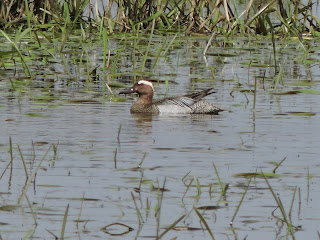Over the last few weeks we’ve also been treated to spectacular views of Hobbies, (on Wheldrake Ings), with up to eight individuals present in the air over and perhaps as many as 13 in the wider LDV area. These birds really are aerial masters, expertly catching dragonflies (and even mayflies and other insects) in their talons before passing them to their beaks to eat on the wing as they continue to feed over the pool. Pool and Swantail Hide are the best places to view them at present, particularly during the afternoon, with birds often coming lower and closer towards dusk as their insect prey descends. Hobbies are the only falcon in Britain that spend the winter months in North Africa, coming to the UK from mid-April and staying until late September and early October, so enjoy them whilst you can! Many thanks to local birder David Gilfillan for the use of his superb photograph taken recently from Swantail Hide, Wheldrake.
Pages
- Home
- May 25
- Apr' 25
- Mar' 25
- Feb' 25
- Jan' 25
- Dec' 24
- Nov' 24
- Oct' 24
- Sep' 24
- Aug' 24
- July 24
- June 24
- May 24
- Apr' 24
- Mar' 24
- Feb' 24
- Jan' 24
- Dec' 23
- Nov' 23
- Oct' 23
- Sep' 23
- Aug' 23
- July 23
- June 23
- May 23
- Apr' 23
- Mar' 23
- Feb' 23
- Jan' 23
- Dec' 22
- Nov' 22
- Oct' 22
- Sept' 22
- Aug' 22
- Jul' 22
- Jun' 22
- May 22
- Apr' 22
- Mar' 22
- Feb' 22
- Jan' 22
- Dec' 21
- Nov' 21
- Oct' 21
- Sep' 21
- Aug' 21
- Jun' 21
- Jul' 21
- Mar' 21
- May 21
- Apr' 21
- Feb' 21
- Nov' 20
- Jan' 21
- Dec' 20
Welcome to the LDV NNR ringing blog, this blog is designed to share the experiences, findings and tales from a group of dedicated ringers. We specialise in conservation orientated research projects, largely focusing on wildfowl, waders, owls and birds of conservation concern, in and around the Vale of York NNR's.
NB - Whilst the purpose of this blog was initially designed to cover our nationally important wildfowl ringing activities, it now also features wildlife and work posts, explaining how we manage the NNR for both wildlife and people.
For daily sightings please visit our Twitter account: https://twitter.com/ldv_nnr (@LDV_NNR)
For details of events, volunteer tasks and wildlife images please visit our Facebook account: https://www.facebook.com/Lower-Derwent-Valley-Skipwith-Common-NNR
Thursday, 31 May 2018
20/05/18 - Corncrakes, Hobbies & Garganey
Over the last few weeks we’ve also been treated to spectacular views of Hobbies, (on Wheldrake Ings), with up to eight individuals present in the air over and perhaps as many as 13 in the wider LDV area. These birds really are aerial masters, expertly catching dragonflies (and even mayflies and other insects) in their talons before passing them to their beaks to eat on the wing as they continue to feed over the pool. Pool and Swantail Hide are the best places to view them at present, particularly during the afternoon, with birds often coming lower and closer towards dusk as their insect prey descends. Hobbies are the only falcon in Britain that spend the winter months in North Africa, coming to the UK from mid-April and staying until late September and early October, so enjoy them whilst you can! Many thanks to local birder David Gilfillan for the use of his superb photograph taken recently from Swantail Hide, Wheldrake.
Thursday, 24 May 2018
15/05/18 - Egret abundance
However, this year it isn’t only the herons that we’ve been keeping an eye on, several (and an increasing number) of pairs of Little Egrets are also present – a species which has been abundant in the valley recently, with a high count of 42 of late. Little Egrets are an increasingly familiar sight in the Lower Derwent Valley these days and are now often more regularly encountered than our resident Grey Herons, especially at Bank Island where birds can currently be seen on a daily basis. In particular over the last month they have been recorded far more than herons, with good concentrations at Bank Island, Wheldrake and North Duffield Carrs, with some notable counts also coming from Sutton Ings and the Low Grounds as well as along the Pocklington Canal.
The first recorded sighting in the valley came in 2001 with the first record of breeding occurring several years later in 2009. Last year numbers increased to at least eight pairs, however this year’s figures look set to be a huge increase on that – more details to follow later in the season. Recently another colour-ringed individual was seen at Bank Island (awaiting details), so please remember to look out for any birds with rings on as this helps us to build up a picture of where ‘our’ local birds are coming from and going to.
Wednesday, 23 May 2018
10/05/18 - 'Terning' up
A week on from getting the first raft out, the water levels had receded enough on Wheldrake, allowing us to access the pool, however with plenty of mud in the way it was quite an exercise carrying the raft in from a long way back due, but as we finally made it onto the pool we were met by the excited calling of a pair of Common Terns – no doubt pleased to see their new home being floated into position! We are also pleased to be able to update you that the tern raft we put out at North Duffield Carrs last week has attracted three pairs of Common Terns – just rewards for everyone’s efforts. Many thanks as always to our team for all the extra help and pairs of hands!



















